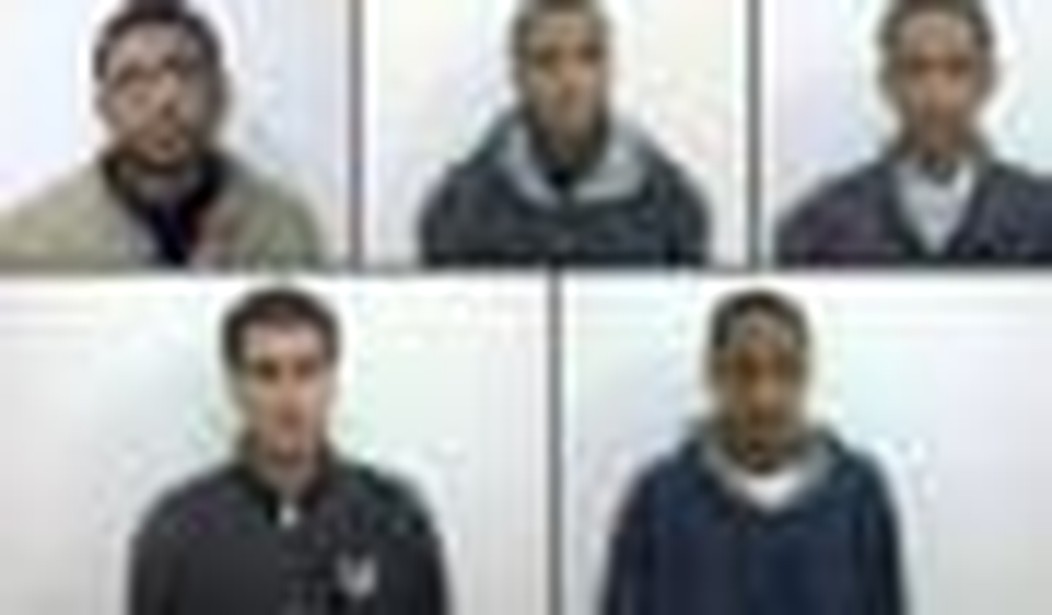Five Americans from the northern Virginia and Washington, D.C., area have been arrested in Pakistan on their way to commit jihad. The fact that they were caught before they got to hook up with those to-die-for 72 virgins (the ones that, according to one Saudi preacher, are white and have no phlegm, feces, urine, or perhaps most appealingly, menstrual cycles) is itself a success in the war on terror. In order to capitalize on this success, though, we need to learn several lessons from the episode.
The first lesson is that we cannot ignore how Pakistan-based extremist groups have penetrated America’s shores. One of the student’s uncles, who is part of the Jaish-e-Mohammed terrorist group, provided them with a safe house where they were ultimately captured. This group was created in the year 2000 after Maulana Masood Azhar, a former senior leader of Harakat ul-Ansar, was released from prison in exchange for 155 hostages. The group is primarily focused on fighting India over Kashmir and has carried out many attacks, including the 2001 attack on India’s parliament, and they are suspected of being linked to plots to kill former Pakistani President Musharraf when he was in office.
The group had training camps in Afghanistan when the Taliban was in power and has received funding from Osama bin Laden. According to the Australian government, the group met with various terrorist organizations in June 2008, where they agreed to shift their focus to removing coalition forces from Afghanistan.
These aren’t the first Americans that JEM has recruited. In 2004, a man in Colorado was deported after it was learned that he had been trained in one of the group’s camps. There are also sympathizers, as found out earlier this year when four men were arrested for plotting to bomb two synagogues in the Bronx and to use Stinger missiles to shoot down military aircraft flying out of the Air National Guard base in Newburgh, New York. The plot was busted when an FBI informant posed as a member of JEM, with whom the ringleader discussed his desire to join the group.
Investigators should be on the lookout for a potential link between the five Americans and Jamaat ul-Fuqra, known in the U.S. as “Muslims of America.” The United Press International reported in 2002 that ul-Fuqra “is a splinter group” of JEM and is also linked to Harakat ul-Mujahideen. As discussed previously, ul-Fuqra has isolated communities in the U.S. that are used as paramilitary training centers, as a videotape recently released by the Christian Action Network shows.
The leadership of both JEM and JUF are based in Lahore, Pakistan, and both are connected to Harakat ul-Mujahideen, the group from which JEM found much of its membership. They share a focus on Kashmir and have longstanding links with the Pakistani government. A high-ranking JEM member was arrested for involvement in the killing of Wall Street Journal reporter Daniel Pearl. Sheikh Gilani, the leader of JUF, was detained for his suspected involvement in the same murder but was released. He maintains today that Daniel Pearl is still alive and was part of an assassination plot against him.
The second lesson is that a narrow definition of what the enemy is will lead to further attacks. We cannot focus only on al-Qaeda, but must recognize that radical Islamic terrorism comes from a conglomerate of interconnected groups pooling their resources. JEM, for example, has given training to other terrorists, including organizations and radicalized individuals.
“The U.S. and British governments have both acquired overwhelming evidence that ‘homegrown’ terror cells seeking instruction at ‘real’ terror training camps frequently end up at either facilities run by LET [Lashkar-e-Taiba] or JEM. JEM is essentially seen as an equal substitute for LET if the latter is unavailable,” says terrorism expert Evan Kohlmann.
The five Americans were arrested at a safe house owned by a member of JEM, which they were using on their way to North Waziristan to train and fight with the Taliban and al-Qaeda. Just because JEM and other groups weren’t the ones that carried out 9/11, it doesn’t mean they don’t share responsibility by acting as part of the infrastructure that enables such attacks to occur.
One more lesson is due. The Pakistani military has more than a few more offensives to begin if it wants its country to stop being a safe harbor for terrorists. The Pakistani police say that the five Americans were first rejected by Jaish-e-Mohammed and Jamaat ud-Dawa because they didn’t have any “references” from people they trusted. If true, then that means the providing of a safe house represents the decision of one JEM member and not the group as a whole. These two organizations still have networks operating in Pakistan with the knowledge of the authorities and any downplaying of JEM and JUD by those authorities should be expected. To indict them in this case is to indirectly indict the Pakistani government. After all, the group first tried to join JEM by approaching one of their madrassas. The Associated Press reported in March how JEM is operating two indoctrination schools that teach students as young as eight years old in Bahawalpur, as well as a facility for martial arts and horse riding. If the AP knows about it, you better believe the Pakistani government knows about it.
Don’t let the successful arrest of these five Americans fool you. Our counterterrorism apparatus is good, but it isn’t perfect. If a blind man is given unlimited darts and enough time, he’ll eventually hit the dartboard. And right now, radical Islamic groups such as these may be disabled from the blows they’ve suffered, but the dartboard will be struck unless they are dismembered.









Join the conversation as a VIP Member